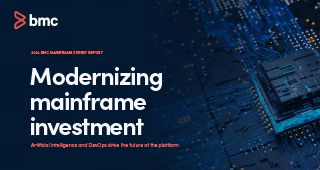The results of the 2021 BMC Mainframe Survey reflect the consistent positive growth outlook seen in recent years, with 92 percent of respondents viewing the mainframe as a platform for long-term growth and new workloads, and 86 percent of extra-large shops expecting MIPS (millions of instructions per second) to grow in the coming year. This is not surprising, considering the disruptive nature of the modern digital economy.
As consumers use more and more digital products every day, and their expectations of easy-to-use, always-available, bug-free digital experiences grow, development teams are under pressure to innovate at a rapid pace and produce high-quality services and applications faster than ever before. In this environment, the mainframe cannot be the department of “no,” or the department of “slow.” Organizations must evolve their processes, tools, and culture to respond quickly to market demands and new business needs.
As the results of the survey show, mainframe Champions—organizations that are increasing their mainframe investment or expect MIPS to grow—have responded to this need by incorporating the mainframe in their enterprise agile development and DevOps initiatives. In doing so, they have improved the stability of their IT infrastructure, the quality of their applications, and the efficiency of their development processes.
Key to this move toward faster, more responsive, and higher-quality development is the adoption of a “shift-left” attitude towards testing. Organizations can no longer afford to develop software, pass it along to operations for testing, wait for bug reports, resolve, and repeat. By shifting testing closer to development and making it part of their automated continuous integration/continuous delivery (CI/CD) pipeline, they can develop quickly and in small increments, rapidly test new code, and ultimately drive more agile release cycles with better overall quality.
Facilitating the Shift Left
Several enhancements included in BMC’s October 2021 mainframe release facilitate this shift left. The addition of non-virtualized PL/I testing to BMC AMI DevX Total Test enables the use of a common testing platform for organizations that use both COBOL and PL/I and gives testers the ability to leverage existing test cases against changes made to PL/I programs.
Two new key performance indicators (KPIs) within BMC AMI zAdviser‘s Quality Dashboard give high-level visibility into code quality. Escaped Abend Ratio identifies the percentage of abends which escape each stage of the development process, giving IT teams insight into areas that may need more thorough testing. Median Time to Detect Since Compile shows when a program which abends was last compiled, helping teams determine the root cause of bugs and adjust testing accordingly.
A shift left in performance testing helps identify potential issues before they make it into production, ultimately saving both time and money. BMC’s mainframe performance testing solution, BMC AMI Strobe, now supports 64-bit applications, enabling organizations to detect and resolve performance issues across a broader range of applications.
Automated Security Compliance Auditing
As organizations look to develop new services and open the mainframe to more applications as quickly as possible, the security of the platform is of paramount concern. For the second consecutive year, security was cited as the top priority for survey respondents, with mainframe Champions focusing on proactive security, real-time visibility, and integration of the mainframe with enterprise security information event management (SIEM).
This quarter, we have added an additional 20 indicators of compromise to BMC AMI Security‘s library. Additionally, we’ve added automated compliance reporting for the Defense Information Systems Agency (DISA) Security Technical Implementation Guide (STIG) to the BMC AMI Security Policy Manager. By automatically auditing security policies against DISA STIG, security experts can save time and resources while preventing compliance drift thanks to real-time automatic alerts of settings changes and the removal of exploitable configuration vulnerabilities.
Enhanced Coverage of Performance Issues
The 2021 BMC Mainframe Survey shows that mainframe Champions are increasingly leveraging the automation, artificial intelligence (AI), machine learning (ML), and embedded domain expertise of AIOps to ease the talent gap created by the retirement of seasoned mainframe professionals. In fact, 57 percent of Champions have reduced the need for specialized skills.
BMC AMI Ops‘ next-generation user interface, introduced in January, provides a strong, intuitive experience for operations on the mainframe that can be utilized by mainframe veterans and newcomers alike. This October, we have released an expanded list of actions that enable operations teams to speed incident response times by responding to performance issues directly from the user interface, without the need to pivot to other screens or tools. We’ve also extended the data that is collected and fed into BMC AMI Ops’ detection capabilities, using ML to enhance multivariate KPI analysis to detect anomalous behavior before it affects performance.
In addition, we’ve extended our probable cause analysis use cases with more coverage for z/OS and Db2 I/O issues. These use cases give users the ability to quickly get a full view of their environment and detect issues right out of the box, without the need of additional data science.
Preparing for the Future
The results of the 2021 BMC Mainframe Survey show that the platform will be an integral part of organizations’ workload infrastructure for decades to come. The enhancements featured in BMC’s October 2021 mainframe release empower our customers to respond to digital disruptions and exceed their customers’ expectations quickly, securely, and efficiently.







